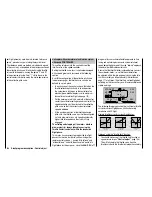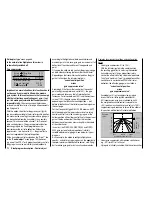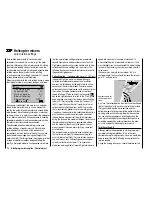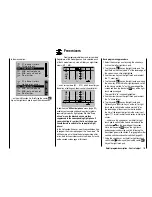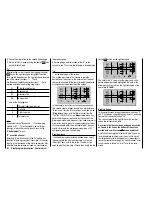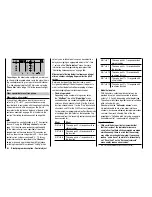
170
Detail program description - Control adjust
C1
Tail
(Static torque compensation)
0%
0%
0%
Tail
C1
?
Input
Output
Point
Nor mal
Cur ve
off
The default approach here is to preset a torque
compensation curve with a linear mixer ratio of a uniform
0%, as is required for a gyro sensor working in "heading
lock mode" – see the screen image above.
Important notice:
In this context, ensure that you comply with the
instructions on adjusting your gyro: if not, you
risk making adjustments that render your heli
impossible to fl y.
If, on the other hand, you use your gyro sensor in the
"normal" operating mode, or if it only has what is termed
"normal mode", then confi gure the mixer as follows:
As with the confi guration of the collective pitch curve
(see page 165), the control curve of the tail rotor can
also be defi ned by up to 6 points. If required, therefore,
you can modify the mixer at any time and preset both
symmetrical and asymmetric mixer ratios both above
and below the hover point. Before you do, however,
ensure you have entered the correct direction of rotation
for the main rotor on the
"Helicopter type"
menu.
present and set – are erased. Following this, the
reference points "L" (input = -100%) and "H" (input
= +100%) are then each set to the
same
value, for
example:
–100%
+30%
+30%
C1
Throttle
L
Input
Output
Point
Nor mal
Cur ve
off
The value to be set depends both on the speed
governor used and on the target motor speed that is
desired, and can, of course, be varied according to the
fl ight phase.
For auto-rotation fl ight, an automatic switch-over
is made from this mixer to a confi gurable default
value; see page 178.
+100%
+30%
Tail
C1
H
+30%
Input
Output
Point
Nor mal
Cur ve
off
Starting with values of -30% for point "L" and +30% for
point "H", the mixer is to be confi gured in such a way
that the helicopter, even during prolonged vertically
ascending or descending fl ights, does not deviate from
the yaw axis as a result of the main rotor's altered
torque while hovering. For hovering, trim should take
place only via the (digital) tail rotor trim lever.
For a reliable torque compensation setting, it is essential
that the collective pitch and throttle curves have been
set up correctly, i.e. that the rotor speed remains
constant over the collective pitch's full adjustment range.
This third curve mixer applies only to the control curve
of the tail rotor servo when the throttle/collective pitch
stick is moved, whereas the "Channel 1 curve" (see
page 119) acts on all servos that are affected by the
throttle/collective pitch stick. Note that the output signal
of the "Channel 1 curve" option also functions as an
input signal for the tail rotor curve programmed here:
In the graph, the vertical line is synchronized with the
throttle/collective pitch stick and follows the current
Channel 1 curve characteristic from the "
Channel 1
curve
" menu.
In the auto-rotation fl ight phase this mixer is
automatically switched off.
Summary of Contents for mx-20 Hott
Page 41: ...41 Your notes...
Page 49: ...49 Your notes...
Page 55: ...55 Your notes...
Page 81: ...81 Your notes...
Page 85: ...85 Your notes...
Page 89: ...89 Your notes...
Page 99: ...99 Detail program description Control adjust...
Page 127: ...127 Detail program description Control adjust...
Page 131: ...131 Detail program description Control adjust...
Page 163: ...163 Detail program description Control adjust...
Page 191: ...191 Detail program description Control adjust...
Page 207: ...207 Detail program description Control adjust...
Page 228: ...228 Detail program description Control adjust...
Page 229: ...229 Detail program description Control adjust...
Page 251: ...251 Detail program description Control adjust...













